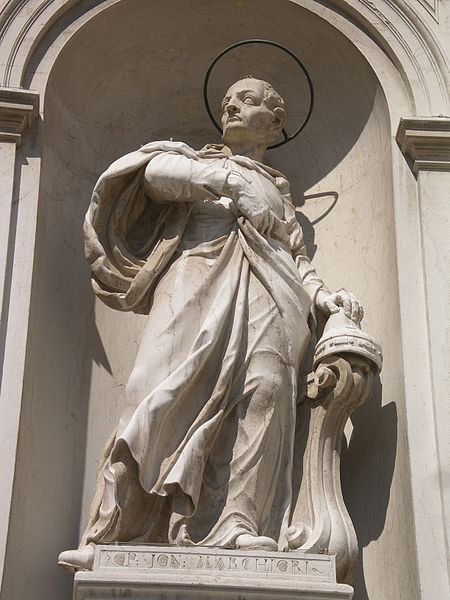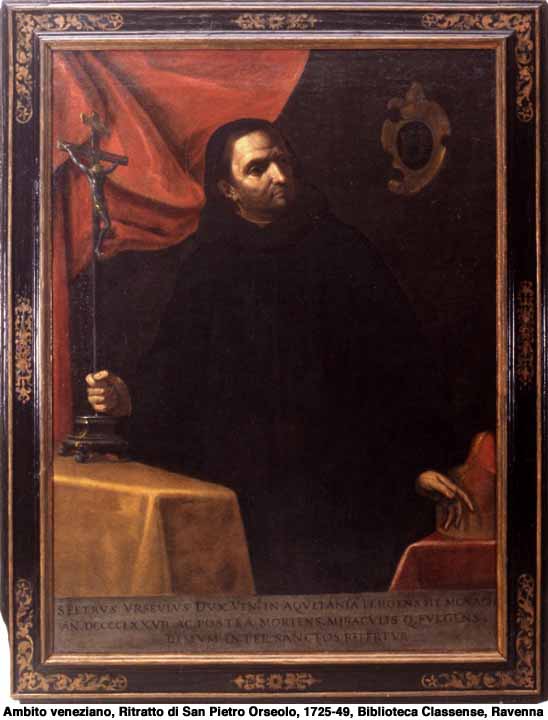St. Pietro I Orseolo, Doge of Venice from 976 to 978.
Born at Rivo alto, Province of Udina, 928; at Cuxa, 10 January, 987 (997 is less probable). Sprung from the wealthy and noble Venetian family, the Orseoli, Peter led from his youth an earnest Christian life. In the service of the republic, he distinguished himself in naval battles against the pirates. In 946 he married a noble Venetian lady, Felicitas; a son of this marriage, who bore the same name as his father, also became Doge of Venice (991-1009).
On 11 Aug., 976, the Doge Pietro Candiano fell a victim to a conspiracy, whose members, in their anxiety to obtain possession of him, set fire to his palace, thereby destroying not only this building, but also the churches of San Marco, San Teodoro, and Santa Maria di Zobenigo, as well as about three hundred houses. On the following day Pietro Orseolo was chosen doge in San Pietro di Castello, but it was only out of regard for his obligations towards his native land that he allowed himself to be prevailed upon to accept the office.
The tradition recorded by Peter Damian (Vita s. Romualdi, V, in P. L., CXLIV, 960), that Peter had taken part in the conspiracy and that his later retirement from the world was due to his desire to expiate therefor, is without foundation. As one might expect from his personal piety, the new doge showed himself a zealous patron of churches and monasteries as well as an able ruler. He had the doge’s palace and the church of San Marco rebuilt at his own expense, procuring in Constantinople for the latter the first golden altar-covering (Pala d’oro), and bequeathed one thousand pounds to persons injured by the fire and a similar sum to the poor.
He renewed the treaty with Capodistria, and succeeded in averting from the republic the vengeance of Candiano’s family, especially of his wife Waldrada, niece of Empress Adelaide, and his son Vitalis, Patriarch of Grado. About this time, through the influence of Abbot Guarinus of Cuxa (a Benedictine monastery at the foot of the Pyrenees, in the territory of Roussillon), he decided to enter a monastery, leaving Venice secretly with the abbot and two companions in the night of 1-2 September, 987.
As a monk in the abbey of Cuxa, he presented to his spiritual brothers a model of humility, zeal for prayer, and charity. For a period he was under the spiritual guidance of St. Romuald. As early as the eleventh century the veneration of Peter Urseolus as a saint was approved by the Bishop of Elne. In 1731 Clement XII ratified this cult, and appointed 14 January as his feast.
MABILLON, Acta SS. ordinis s. Benedicti, V, 878 sqq.; Bibliotheca hagiographica latina, II, 986; TOLRA, St Pierre Orséolo (Paris, 1897); SCHMID, D. hl. Petrus Orseolo, Doge von Venedig u. Benedictiner, in Studien und Mitteilungen aus dem Bened. u. Cisterzienserorden (1901), 71 sq., 251 sq.; KRETSCHMAY, Gesch. von Venedig, I (Gotha, 1905), 115 sq., 438 sq.
J.P. KIRSCH (Catholic Encyclopedia)





No comments:
Post a Comment